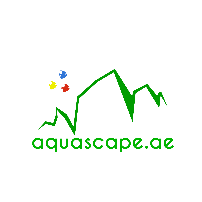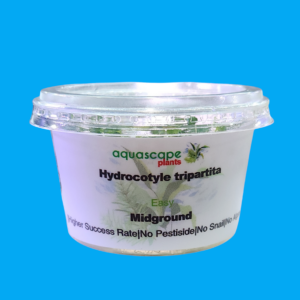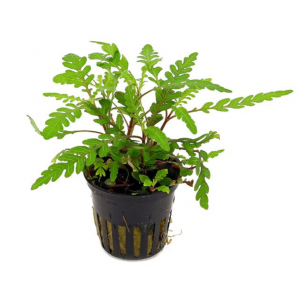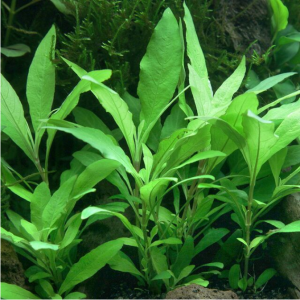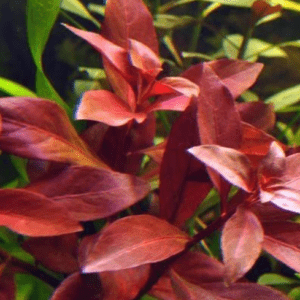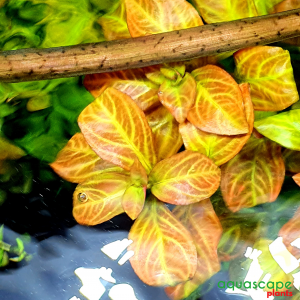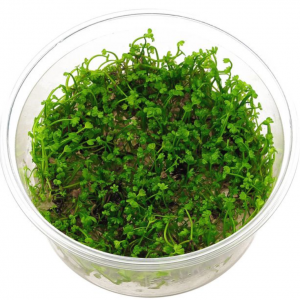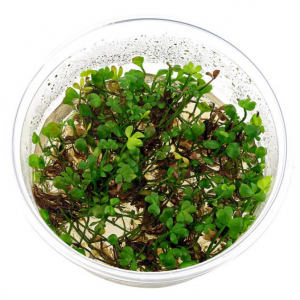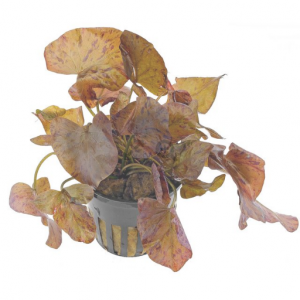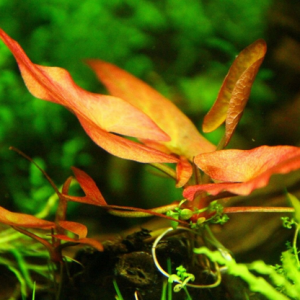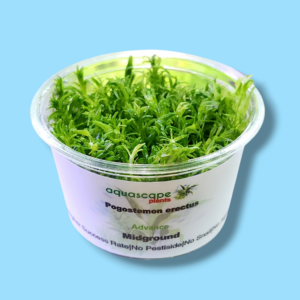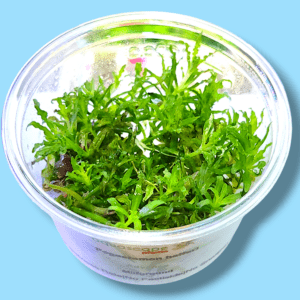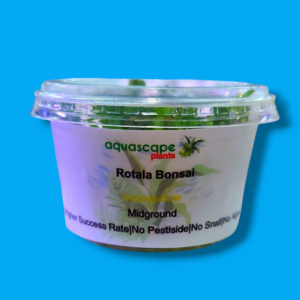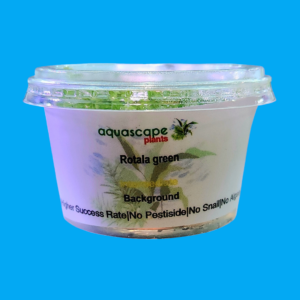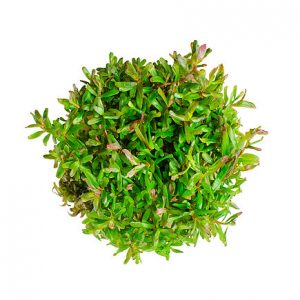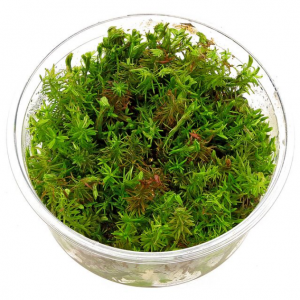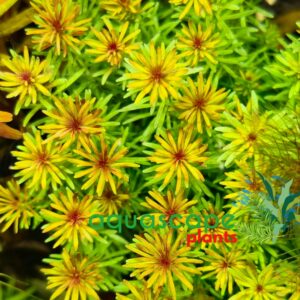Subtotal: د.إ33.15
Live Plants & Neutrients
Showing 49–72 of 245 results
-
Sold out!Plants, Tissue Culture Cup
Aquascapeplants Helanthium vesuvius
The narrow, tightly spiralling fresh green leaves are pointy and make this Helanthium vesuviusa real eye-catcher. The plant is very decorative as a group or as solitary plant in the middle ground of the aquarium. Under favourable conditions it spreads fast through runners. When cultivated above the waterline, the emerged leaves are almost straight. Only under water it develops its typical spiralling leaves.
- Very narrow, spiraling leaves
- Fresh green colour
- Moderate height
- Forms runners
Common names Corkscrew sword Synonyms Echinodorus ‘Vesuvius’, Echinodorus bolivianus ‘Vesuvius’, Echinodorus sp. tortifolia Complete botanical name Helánthium boliviánum (Rusby) Lehtonen & Myllys Family Alismataceae Genus Helanthium Difficulty easy Usage Background, Midground, Nano tanks Growth fast SKU: n/a -
Plants, Tissue Culture Cup
Aquascapeplants Hemianthus callitrichoides ‘cuba’
Hemianthus callitrichoides ‘Cuba’, commonly known as Dwarf Baby Tears, is a highly sought-after aquatic plant among aquarists.
Hemianthus callitrichoides ‘Cuba’ Overview
Common Name: Dwarf Baby Tears
Scientific Name: Hemianthus callitrichoides ‘Cuba’
Family: Scrophulariaceae
Origin: Cuba
Appearance
Leaves: Tiny, round, and bright green, forming a lush carpet
Height: Grows up to 3 cm (1.2 inches)
Growth Rate: Slow to moderate, depending on conditions
Care Requirements
Lighting: High intensity to maintain its compact growth and vibrant color
CO2: Beneficial for optimal growth, especially in high-light setups
Water Parameters:
- pH: 5.0 to 7.5
- Hardness: Soft to moderately hard water
- Temperature: 21 to 28 °C (70 to 82 °F)
Substrate
Prefers nutrient-rich substrates to support healthy growth.
Propagation
Propagated by cutting the stems and replanting the cuttings. It spreads quickly to form a dense carpet.
Special Considerations
- Requires stable water conditions and regular maintenance to prevent algae growth.
- Ideal for foreground planting in both small and large aquariums.
Hemianthus callitrichoides ‘Cuba’ is perfect for creating a stunning, green carpet in your aquarium, making it a favorite among aquascapers. Happy aquascaping!
SKU: n/a -
Plants, Tissue Culture Cup
Aquascapeplants Hydrocotyle tripartita
Hydrocotyle tripartita
- 3x times more plant quantity than other leading brands..
- Forms creeping or overhanging shoots
- Pretty leaf form
- Fresh light green colour
- Can be used in many different ways
- One of the most popular plants in aquascaping
Synonyms Hydrocotyle sp. ”Australia”, Hydrocotyle sp. ”Japan” Misapplied names Hydrocotyle maritima Family Araliaceae Genus Hydrocotyle Difficulty easy Usage Midground, Nano tanks, Foreground, group, Foreground, ground cover Growth very fast pH value 5 – 7 SKU: n/a -
Sold out!Plants, Potted
Aquascapeplants Hygrophila pinnatifida
Size: Pot
Maharashtra, Goa, Karnataka, Tamil Nadu are the states in India where Hygrophila pinnatifida is commonly found. However in the books its origin is from North India state of India, Uttar Pradesh.
- Artistic leave pattern
- To artistic to be believed real
- Can be planted in soil or attached to the hardscape
- Relatively easy to grow and care
Synonyms Nomaphila pinnatifida Dalzell, Cardanthera pinnatifida (Dalzell) Benth. ex C.B.Clarke . Complete botanical name Hygróphila pinnatífida (Dalzell) Sreem. Family Acanthaceae Genus Hygrophila Difficulty medium Usage Epiphyte (growing on hardscape), Semi-emersed plant for open tanks, Midground, Foreground, group Height 5 – 40cm Width 10 – 30cm Growth medium SKU: n/a -
Plants, Tissue Culture Cup
Aquascapeplants Hygrophila pinnatifida
Maharashtra, Goa, Karnataka, Tamil Nadu are the states in India where Hygrophila pinnatifida is commonly found. However in the books its origin is from North India state of India, Uttar Pradesh.
- 3x times more plant quantity than other leading brands..
- Artistic leave pattern
- To artistic to be believed real
- Can be planted in soil or attached to the hardscape
- Relatively easy to grow and care
Synonyms Nomaphila pinnatifida Dalzell, Cardanthera pinnatifida (Dalzell) Benth. ex C.B.Clarke . Complete botanical name Hygróphila pinnatífida (Dalzell) Sreem. Family Acanthaceae Genus Hygrophila Difficulty medium Usage Epiphyte (growing on hardscape), Semi-emersed plant for open tanks, Midground, Foreground, group Height 5 – 40cm Width 10 – 30cm Growth medium Buy 5 or more for additional discount!
Buy 10 or more to get super discount!
SKU: n/a -
Sold out!Plants, Tissue Culture Cup
Aquascapeplants Hygrophila siamensis 53B
Hygrophila corymbosa ‘Siamensis 53B’ is a variant of Hygrophila corymbosa ‘Siamensis’. This Hygrophila ‘Siamensis 53B’ forms an incredible amount of side shoots and becomes bushy relatively rapidly. Stems becomes 15-40 cm tall and 7-12 cm wide
- Intensively branching
- Light green
- Narrower leaves than regular ‘Siamensis’
- Undemanding
- Fast growing
SKU: n/a -
Plants, Potted
Aquascapeplants Ludwigia repens ‘super red’
Size: Pot
Ludwigia repens ‘super red’ is easy to maintain and can still achieve intense wine red color.
- Undemanding
- Makes a good show with larger groups
- Intense super red color
Synonyms Ludwigia aff. glandulosa, Ludwigia repens ‘Rubin’, Ludwigia sp. ”Weinrot” Family Onagraceae Genus Ludwigia Difficulty easy Usage Accent (red), Background, Midground Aquascaping very colourful plant for accents Growth fast SKU: n/a -
Plants, Potted
Aquascapeplants Ludwigia sp. ‘Dark Orange’
Ludwigia dark orange (‘Atlantis’)
- Also known as Ludwigia sp. ‘Atlantis’
- Attractive yellow to dark orange colours
- Light leaf nervature
- Medium growth rate
Synonyms Ludwigia sp. ‘Dark Orange’ Family Onagraceae Genus Ludwigia Difficulty easy Usage Background, Midground Aquascaping very colourful plant for accents Growth fast pH value 5 – 8 Temperature tolerance 4 – 30°C Carbonate hardness 2 – 22°dKH Propagation Cuttings SKU: n/a -
Sold out!Plants, Tissue Culture Cup
Aquascapeplants Marsilea crenata
- 3x times more plant quantity than other leading brands..
- Forms very small leaves
- Submersed leaves are roundish, on a stalk
- Forms a 1-3 cm high and close carpet
- New leafes with brown color
Complete botanical name Marsílea crenáta C. Presl Family Marsileaceae Genus Marsilea Usage Foreground, ground cover Aquascaping forms a small-leaved carpet General hardness 0 – 30°dGH Propagation Runners, Splitting, cutting off daughter plants Can grow emersed? yes SKU: n/a -
Plants, Tissue Culture Cup
Aquascapeplants Marsilea hirsuta
Mostly found in Australia Marsilea hirsuta is a slow growing plant but with addition of co2 in aquariums it can grow and spread fast thanks to its runner shoots. Mostly the leaves looks four leaved clover but with time and water condition the leaves might change to two or three clover.
- 3x times more plant quantity than other leading brands..
- New leaves are brown in color making to look a flower
- Grows as close carpet with 2cm high
- Most robust carpeting plant
Common names Hansen’s Nardoo Synonyms Marsilea azorica Launert & Paiva Complete botanical name Marsílea hirsúta R. Br. Family Marsileaceae Genus Marsilea Usage Foreground, ground cover Aquascaping forms a small-leaved carpet SKU: n/a -
Sold out!Plants, Potted
Aquascapeplants Microsorum pteropus ‘Trident’ Trident Java fern
Size: pot
Microsorum pteropus ‘Trident’ is a rare type of Java fern and there is still supply shortage and high demand in the aquarium hobby industry.
- Low growth
- Very easy to care
- narrow leave
Synonyms Microsorum pteropus ‘Fingers’ Complete botanical name Microsórum ptéropus (Blume) Copeland Family Polypodiaceae Genus Microsorum Difficulty very easy Usage Epiphyte (growing on hardscape), Midground Growth slow SKU: n/a -
Plants, Potted
Aquascapeplants Nymphaea ‘Tiger lotus green’
Aquascapeplants Nymphaea ‘Tiger lotus green’
Gorgeous solitary plant for bigger tanks
Greenish -green to red leaves
Dark spot and stripe pattern
The most popular waterlily in the aquarium hobbyThe Nymphaea ‘Tiger Lotus Green’ is a stunning aquatic plant, often referred to as the Green Tiger Lotus. Despite its name, it is actually a type of water lily, not a true lotus. Here are some key points about this plant:
- Appearance: It features heart-shaped leaves with a brilliant reddish-purple tint. The leaves can grow both submerged and floating, adding a dynamic look to your aquarium.
- Growth: This plant is known for its fast growth rate and can become quite large, making it suitable for midground or background placement in your tank.
- Care: The Green Tiger Lotus is undemanding but a heavy feeder. It thrives with regular fertilization and can benefit from CO2 supplementation. It can tolerate a wide range of temperatures and pH levels.
- Pruning: To manage its size and prevent it from shading other plants, you can prune the floating leaves.
- Propagation: It can produce flowers and seeds, and under good conditions, it can develop offset plantlets that can be separated and planted in other tanks.
SKU: n/a -
Sold out!Plants, Potted
Aquascapeplants Nymphaea ‘Tiger lotus red’
Aquascapeplants Nymphaea ‘Tiger lotus red’
- Gorgeous solitary plant for bigger tanks
- Reddish-green to red leaves
- Dark spot and stripe pattern
- The most popular waterlily in the aquarium hobby
Complete botanical name Nympháea lótus L. Family Nymphaeaceae Genus Nymphaea Difficulty easy Usage Background, Midground Aquascaping very colourful plant for accents Growth fast pH value 5 – 8 Temperature tolerance 15 – 30°C SKU: n/a -
Plants, Potted
Aquascapeplants Pogostemon erectus
Size: Pot
Pogostemon erectus was originally collected for agriculture in western Maharashtra a state in India, and recently started to be used in aquariums.
- Light green leaves
- Bushy growth
- pointed, neadle like leaves
- sharp vertical growth
Synonyms Dysophylla erecta Dalzell, Eusteralis erecta (Dalzell) Panigrahi Family Lamiaceae Genus Pogostemon Difficulty medium Usage Background Aquascaping fine-leaved Growth fast Buy 5 or more for additional discount!
Buy 10 or more to get super discount!
SKU: n/a -
Plants, Tissue Culture Cup
Aquascapeplants Pogostemon erectus
Pogostemon erectus is a dense growing plant with needle type leaves, originating from India.
- Compact growth patter
- Needle type leaves
- Ideal for nano tanks
- Green lush color
Synonyms Dysophylla erecta Dalzell, Eusteralis erecta (Dalzell) Panigrahi Complete botanical name Pogostémon eréctus (Dalzell) Kuntze Family Lamiaceae Genus Pogostemon Difficulty medium Usage Background Aquascaping fine-leaved Growth fast SKU: n/a -
Plants, Tissue Culture Cup
Aquascapeplants Pogostemon helferi
Size: Cup
Pogostemon helferi: The Star of Your Aquascape
Description: Introducing Pogostemon helferi, also known as Downoi, an exquisite aquatic plant celebrated for its unique star-shaped leaves and compact growth. This plant is a fantastic choice for creating a dynamic and visually appealing underwater garden.
Key Features:
- Distinctive Appearance: Known for its curled, bright green leaves that form a rosette shape, adding a striking visual element to any tank.
- Ideal for Aquascaping: Perfect for foreground planting, providing a textured contrast to other plants and enhancing the overall aesthetics of your aquarium.
- Hardy and Versatile: Adapts well to various water conditions (pH 6.0-7.5, temperature 20-28°C), making it suitable for both beginners and experienced aquarists.
- Easy Propagation: Spreads through runners, allowing you to easily propagate and create a lush carpet effect in your tank.
- Available in the UAE: Readily accessible for aquarium enthusiasts in the United Arab Emirates, ensuring you can effortlessly add this stunning plant to your collection.
Common names Downoi Synonyms Anuragia helferi (Hook. f.) Raizada, Dysophylla helferi Hook. f., Eusteralis helferi (Hook. f.) Panigrahi Complete botanical name Pogostémon hélferi (Hook. f.) Press Family Lamiaceae Genus Pogostemon Difficulty medium Usage Epiphyte (growing on hardscape), Midground, Nano tanks, Foreground, group Growth medium SKU: n/a -
Sold out!Plants, Tissue Culture Cup
Aquascapeplants Rotala Bonsai
Rotala Bonsai is a trade name for the originally known plant Rotala Indica. Rotala Bonsai can be easily identified among other Rotala by it flowers. Rotala Indica/ Rotala Bonsai is very suited in nano aquariums thanks to its smaller leaves. The round leaves looks best when its planted together in large portions.
In bigger tank Rotala Bonsai can be planted in larger groups.
Common names Indian toothcup Synonyms Ameletia indica (Willd.) DC. Misapplied names Ammania sp. ”Bonsai”, Ammannia sp. ”Bonsai” Trader names Ammania bonsai Complete botanical name Rotála índica (Willd.) Koehne Family Lythraceae Genus Rotala Difficulty medium Usage Midground, Nano tanks, Street (Dutch style), Foreground, group Growth medium pH value 5 – 7 Rotala Bonsai: A compact and visually appealing aquatic plant, Rotala Bonsai is a favorite among aquascapers for its neatly rounded leaves and bushy growth habit. Perfect for midground or foreground placement, this plant adds structure and a pop of vibrant green or reddish hues to freshwater aquariums.
Rotala Bonsai thrives under moderate to high lighting and benefits from CO2 supplementation for optimal coloration and dense growth. Its slow-to-moderate growth rate makes it easy to maintain, requiring occasional trimming to maintain its shape and encourage healthy growth.
Ideal for nano tanks and intricate aquascapes, Rotala Bonsai is versatile, adapting well to various aquascaping styles. With its unique appearance and ease of care, this plant brings a touch of elegance and natural beauty to any planted aquarium setup.
SKU: n/a -
Sold out!Plants, Tissue Culture Cup
Aquascapeplants Rotala Green
Rotala is a popular aquatic plant in the aquarium hobby, known for its vibrant colors and delicate foliage. Rotala Green, specifically, is a variety that is easier to care for compared to some of its more demanding relatives like Rotala rotundifolia or Rotala indica. Below is a comprehensive guide to help you grow and maintain Rotala Green in your aquarium.
1. Overview of Rotala Green
- Scientific Name: Rotala rotundifolia ‘Green’
- Family: Lythraceae
- Origin: Southeast Asia
- Difficulty: Easy to Moderate
- Growth Rate: Fast
- Light Requirements: Moderate to High
- CO2 Requirements: Low to Medium (benefits from CO2 supplementation)
- Placement: Midground to Background
2. Tank Requirements
- Temperature: 72°F – 82°F (22°C – 28°C)
- pH: 6.0 – 7.5
- Water Hardness: Soft to moderately hard (2-15 dGH)
- Substrate: Nutrient-rich substrate or root tabs for optimal growth
- Lighting: Moderate to high lighting (2-4 watts per gallon or 40-80 PAR)
- CO2: Not mandatory but recommended for denser growth and vibrant color
SKU: n/a -
Sold out!Plants, Tissue Culture Cup
Aquascapeplants Rotala macrandra Japan
Rotala macrandra also known as giant red rotala is a beautiful red stem plant with distinctive wavy leaves.
- Red color stem plant
- Have distinctive wavy leaves
- Great contrast with green plants
common names Giant Red Rotala Complete botanical name Rotála macrándra Koehne Family Lythraceae Genus Rotala Difficulty medium Usage Accent (red), Background, Midground, Street (Dutch style) Aquascaping very colourful plant for accents Growth fast pH value 4 – 7 Rotala macrandra Japan: The Aquatic Jewel for Your Aquarium
Description: Elevate the beauty of your aquarium with Rotala macrandra Japan, a stunning aquatic plant known for its vibrant red and pink hues. This plant is perfect for creating a striking focal point in your tank and is favored by aquarists for its eye-catching appearance.
Key Features:
- Vibrant Colors: Boasts striking red and pink foliage that adds a pop of color to any aquarium setup.
- Ideal for Aquascaping: Its delicate, fine leaves create a beautiful contrast with other plants, making it perfect for detailed aquascapes.
- Moderate Care: Thrives in well-maintained aquariums with high light levels and CO2 supplementation, making it suitable for intermediate to experienced aquarists.
- Growth: Grows best in nutrient-rich substrates and benefits from regular pruning to maintain its shape and promote bushier growth.
- Available in the UAE: Easily accessible for aquarium enthusiasts in the United Arab Emirates, ensuring you can add this exquisite plant to your collection.
 SKU: n/a
SKU: n/a -
Sold out!Plants, Potted
Aquascapeplants Rotala var.’Pearl’
Size: Price Per Stem
Rotala var.’Pearl’ is a beautiful aquatic plant that is majorly found in Pakistan, India and Nepal.
Tiny leaves ideal for nano or even larger scapes
Ideal to be placed foreground or midground
Recommended to use co2 and plant neutrient Easylife Profito along with Easylife Ferro Iron.SKU: n/a -
Sold out!Plants, Tissue Culture Cup
Aquascapeplants Rotala Vietnam H’ra
As the name suggested H’ra, Rotala was discovered in H’ra central Vietnam.
- Rotalal Vietnam H’ra is also know as Rotala sp. Gia Lai
- Orange, reddish and green leaves
- Busy growth
Synonyms Rotala sp. “Gia Lai”, Rotala sp. “H’Ra” Complete botanical name Rotála rotundifólia (Buch.-Ham. ex Roxb.) Koehne Family Lythraceae Genus Rotala Difficulty easy Usage Background, Midground Aquascaping very colourful plant for accents Height 20 – 80cm Width 2 – 4cm Growth fast Buy 5 or more for additional discount!
Buy 10 or more to get super discount!
SKU: n/a -
Sold out!Plants, Potted
Aquascapeplants Rotala wallichii
Rotala wallichii is a popular aquatic plant in the aquarium hobby, known for its delicate, feathery appearance and vibrant colors under the right conditions. Here’s a comprehensive care guide to help you grow and maintain this beautiful plant:
1. Overview
- Scientific Name: Rotala wallichii
- Common Name: Whorly Rotala
- Origin: Southeast Asia
- Difficulty Level: Moderate to Advanced
- Growth Rate: Fast
- Light Requirement: High
- CO2 Requirement: Recommended
2. Tank Requirements
- Tank Size: Minimum 10 gallons (larger tanks are easier to stabilize).
- Water Temperature: 72–82°F (22–28°C).
- pH Level: 5.5–7.0 (slightly acidic to neutral).
- Water Hardness: Soft to moderately hard (2–12 dGH).
SKU: n/a

 Peperomia Green Baby Rubber Plant
Peperomia Green Baby Rubber Plant 